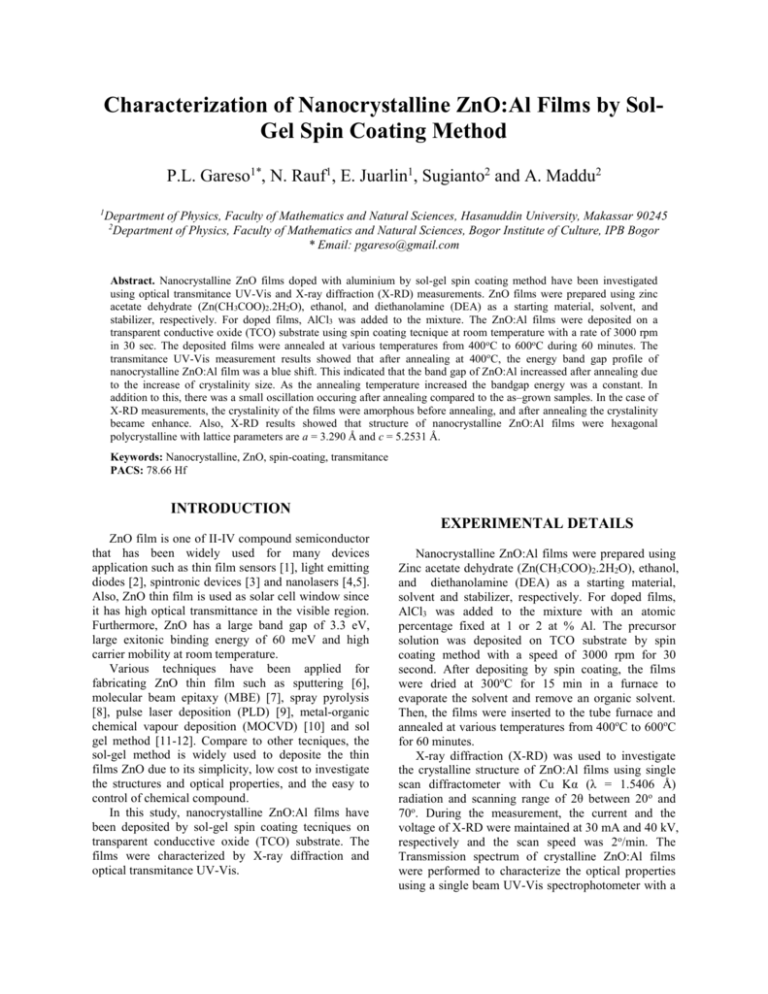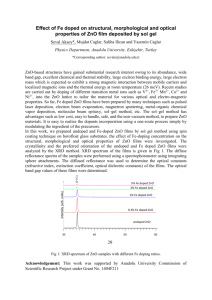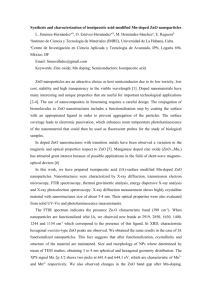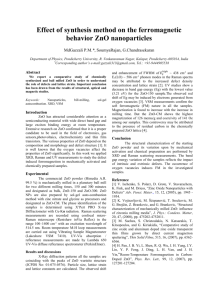View/Open
advertisement

Characterization of Nanocrystalline ZnO:Al Films by SolGel Spin Coating Method P.L. Gareso1*, N. Rauf1, E. Juarlin1, Sugianto2 and A. Maddu2 1 Department of Physics, Faculty of Mathematics and Natural Sciences, Hasanuddin University, Makassar 90245 2 Department of Physics, Faculty of Mathematics and Natural Sciences, Bogor Institute of Culture, IPB Bogor * Email: pgareso@gmail.com Abstract. Nanocrystalline ZnO films doped with aluminium by sol-gel spin coating method have been investigated using optical transmitance UV-Vis and X-ray diffraction (X-RD) measurements. ZnO films were prepared using zinc acetate dehydrate (Zn(CH3COO)2.2H2O), ethanol, and diethanolamine (DEA) as a starting material, solvent, and stabilizer, respectively. For doped films, AlCl3 was added to the mixture. The ZnO:Al films were deposited on a transparent conductive oxide (TCO) substrate using spin coating tecnique at room temperature with a rate of 3000 rpm in 30 sec. The deposited films were annealed at various temperatures from 400 oC to 600oC during 60 minutes. The transmitance UV-Vis measurement results showed that after annealing at 400oC, the energy band gap profile of nanocrystalline ZnO:Al film was a blue shift. This indicated that the band gap of ZnO:Al increassed after annealing due to the increase of crystalinity size. As the annealing temperature increased the bandgap energy was a constant. In addition to this, there was a small oscillation occuring after annealing compared to the as–grown samples. In the case of X-RD measurements, the crystalinity of the films were amorphous before annealing, and after annealing the crystalinity became enhance. Also, X-RD results showed that structure of nanocrystalline ZnO:Al films were hexagonal polycrystalline with lattice parameters are a = 3.290 Å and c = 5.2531 Å. Keywords: Nanocrystalline, ZnO, spin-coating, transmitance PACS: 78.66 Hf INTRODUCTION EXPERIMENTAL DETAILS ZnO film is one of II-IV compound semiconductor that has been widely used for many devices application such as thin film sensors [1], light emitting diodes [2], spintronic devices [3] and nanolasers [4,5]. Also, ZnO thin film is used as solar cell window since it has high optical transmittance in the visible region. Furthermore, ZnO has a large band gap of 3.3 eV, large exitonic binding energy of 60 meV and high carrier mobility at room temperature. Various techniques have been applied for fabricating ZnO thin film such as sputtering [6], molecular beam epitaxy (MBE) [7], spray pyrolysis [8], pulse laser deposition (PLD) [9], metal-organic chemical vapour deposition (MOCVD) [10] and sol gel method [11-12]. Compare to other tecniques, the sol-gel method is widely used to deposite the thin films ZnO due to its simplicity, low cost to investigate the structures and optical properties, and the easy to control of chemical compound. In this study, nanocrystalline ZnO:Al films have been deposited by sol-gel spin coating tecniques on transparent conducctive oxide (TCO) substrate. The films were characterized by X-ray diffraction and optical transmitance UV-Vis. Nanocrystalline ZnO:Al films were prepared using Zinc acetate dehydrate (Zn(CH3COO)2.2H2O), ethanol, and diethanolamine (DEA) as a starting material, solvent and stabilizer, respectively. For doped films, AlCl3 was added to the mixture with an atomic percentage fixed at 1 or 2 at % Al. The precursor solution was deposited on TCO substrate by spin coating method with a speed of 3000 rpm for 30 second. After depositing by spin coating, the films were dried at 300oC for 15 min in a furnace to evaporate the solvent and remove an organic solvent. Then, the films were inserted to the tube furnace and annealed at various temperatures from 400oC to 600oC for 60 minutes. X-ray diffraction (X-RD) was used to investigate the crystalline structure of ZnO:Al films using single scan diffractometer with Cu Kα (λ = 1.5406 Å) radiation and scanning range of 2θ between 20 o and 70o. During the measurement, the current and the voltage of X-RD were maintained at 30 mA and 40 kV, respectively and the scan speed was 2o/min. The Transmission spectrum of crystalline ZnO:Al films were performed to characterize the optical properties using a single beam UV-Vis spectrophotometer with a wavelength range of 250 nm – 800 nm. The band gap energy of ZnO:Al films were obtained from the transmission specrum. It also shows in Figure 1 that the energy band gap of ZnO:Al after annealing is blue shift in comparison to the as-grown samples. This is probably due to the increase of the grain size of ZnO:Al. RESULTS AND DISCUSSION Figure.1 shows the optical transmitance spectrum of nanocrystalline ZnO:Al films before and after annealing at various temperatures from 400oC to 600oC. It can be seen in this graph that the optical transmitance spectrum is a broadening in comparison to the samples after annealing. The transmitance is below 80% in the range of wavelength 300 – 500 nm. After annealing the transmitance spectrum become narrow and there is a sharp absorption edge located at 370 – 380 nm. This is indicated that in the as-grown sample, the absorption edge is smaller than after annealing due to the crystalinity in the as-grown sample is lower in comparison to the sample after annealing. In addition to this, after annealing there is a oscillation spectrum occuring in the range of wavelength 400 nm-800 nm. The corresponding optical band gap of ZnO:Al films is estimated by extrapolation of the linier relationship between (αhυ)2 and hυ according to the equation αhυ = A (hυ – Eg)1/2 (1) where α is the absorption coefficient, hυ is the photon energy, Eg is the optical band gap and A is a constant. Based on this equation the band gap value of ZnO:Al will be determined. Fig.2. X-RD spectra of nanocrystalline ZnO:Al films before and after annealing at various temperature from 400oC to 600oC for 60 minutes Figure 2 displays the X-ray diffraction spectrum of nanocrystalline ZnO:Al films after annealing at with different annealing temperature from 400 oC to 600oC. The X-RD patterns of as-grown sample are also included for comparison. In the case of as-grown sample ZnO:Al films, the spectra of X-RD merely show for aluminium holder of the sample, while the XRD spectrum of ZnO:Al were not observed. This indicates that the ZnO:Al is still amorphous due to the grain size of the crystallinity is small. After annealing, more additional peaks were observed due to the increase of the crystalinity of ZnO:Al films. As temperature annealing increase, the spectrum width become narrowing that indicates that the grain size increases. The unit cell ‘a” and “c” of the nanocrystalline ZnO:Al films (002) orientation are calculated using the relation (1) and (2) 𝑎 = √1⁄3 𝜆⁄𝑠𝑖𝑛𝜃 c = 𝜆/𝑠𝑖𝑛𝜃 Fig.1. The optical transmitance spectrum of nanocrystalline ZnO:Al films before and after annealing at various temperature from 400oC to 600oC for 60 minutes. (2) (3) From the XRD spectrum, grain size (D) of the film is calculated using the Debye Scherrer formula, D = kλ/β cosθ (4) Where k is a constant, λ, β, and θ are the X-ray wavelength, full width at half maximum (FWHM) and Bragg angle respectively. Table.1 shows the structural parameters of nanocrystalline ZnO:Al film Table.1. Structural parameters of nanocrystalline ZnO:Al films Sample plane FWHM 2 θ(deg) d(Å) As-grown 0 0 0 002 400oC 0.1917 35.4683 2.5606 500oC 0.2350 35.4683 2.5335 600oC 0.2433 35.4683 2.5288 The dislocation density (δ), which represents the amount of defects in the crystal, is estimated from the following equation: δ = 1/D2 (5) While the strain (ε) of the film is determined from the following equation: ε = β cosθ/4 (6) SUMMARY We have investigated the structural and optical characterization of nanocrystalline ZnO:Al films grown by sol-gel spin coating using x-ray diffraction and optical transmitance UV-Vis diffractophotometer. X-RD measurement shows that there is no diffraction pattern was observed in ZnO:Al before annealing. After annealing there is more additional X-RD peaks were observed. This indicates that the cyrstallinity the sample of nanocrystalline ZnO:Al became enhance. The results are also confirmed in the optical transmitance that the sample of ZnO:Al become amorphous before annealing. ACKNOWLEDGMENTS The authors acknowledge the financial support from the higher education of Indonesia (DIKTI) through out LP2M-UNHAS under contract number of 110/UN4-42/LK.26/SP-UH/2013. REFERENCES 1. S. T. Shishiyanu, T. S, Shishiyanu and O. I. Lupen, Sensors and Actuators B: Chemical, 107, 379-386 (2005). 2. N. Saito, H. Haneda, T. Sekiguchi, N. Ohashi, I. Sakaguchi and K. Koumoto, Advanced Materials, 14, 418-421 (2002). 3. T. Meron and G. Morkovich, Journal of Physical Chemistry B, 109, 20232-20236 (2005) 4. M. H. Huang, S. Mao, H. Feick, H. Yan, Y. Wu, H. Kind, E. Weber, R. Russo and P. Yang, Science, 292, 1897-1899 (2001) 5. C. Jagadish, and S. Pearton (Editors), Zinc Oxide Bulk, Thin Film and Nanostructures, Elsevier, 2006. 6. P. Nanes, D.Costa, E. Furtunato and R. Martins, Vacuum, 64, 293-297 (2002) 7. D.C. Look, D. C. Reynolds, C. W. Litton, R. L. Jones, D. B. Eason and G. Gantwell, Appl. Phys. Lett, 81, 1830-1832 (2002). 8. M. Krunks and E. Mellikov, Thin Solid Films, 270, 33-36 (1995). 9. X. L. Wu, G. G. Siu, C. L. Fu, and H. C. Ong, Appl. Phys. Lett, 78, 2285-2287 (2001) 10. K. Tominaga, T. Takao, A. Fukushima, T. Moriga and L. Nakabayashi, Vacuum, 66, 505-509 (2002) 11.E. J. Luna-Arredondo, A. Mmaldonado, R. Asomoza, D. R. Acosta, M. A. Melendez-lina and M. de la L. Olvera, Thin solid Film, 490, 132-136 (2005). 12.L. J. Mandalapu, F. X. Xiu, Z. Yang, D. T. Zhao and J. L. Liu, Apply, Phys. Lett, 88, 112108112110 (2006).




